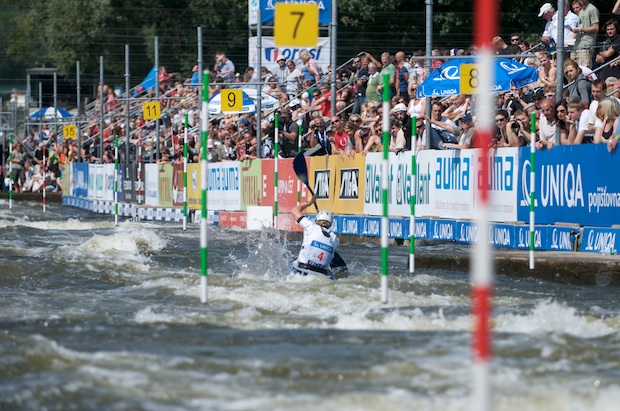Contributors - Paddlesports Back to overview
Canoe Slalom

['Canoe slalom' (International Canoe Federation terminology) refers to both canoe and kayak slalom.]
The Formula 1 of paddle sports, slalom paddling is a formidable test of not only paddling speed, but also explosive power, physical and mental stamina, boat balance and razor sharp technical ability in choosing the fastest lines over boils, drops, waves, stoppers as well as moving in and out of bankside eddies.
Developed in 1922 in Switzerland, slalom paddlers rapidly descend down varying grades of whitewater towards a finish line about 300m away while weaving through a course of hanging gates. The goal is to get to the finish line with the fastest time possible (and the least amount of penalties).
Each course includes approximately 18-24 hanging gates which must be navigated, they are colour-coded to indicate which direction the paddler must pass through them. Green gates are traversed heading downstream, whilst red gates require the paddler to change direction and steer through them heading upstream.
Upstream gates are typically placed in eddies where the water is flat or moving slightly upstream, and there must be 6-8 upstream gates for a certified course. Downstream gates may also be placed in eddies to increase the difficulty or in the current; these can be offset to alternating sides of the current requiring rapid turns in fast-moving water.
Runs down the course are both timed for overall speed as well as penalised for missed gates (+50 seconds per miss) and gate-touches (+2 seconds per touch). The combined time makes the total score for each run. Depending on the difficulty of the course, it could take roughly 90-120 seconds to complete the course.
There are two different boat classes:
Kayaks - closed-deck, single person boats with the paddler sitting and manoeuvring the course with double-blade paddle
Canoes - closed-deck and either singles (one person) or doubles (2 person) boats with the paddler(s) kneeling on both knees whilst paddling with a single-blade paddle that has a T-shaped handle.
Many athletes compete in both classes due to their similarities, but if you ever ask one of them, they will always tell you that the sensation and the technique required are worlds apart.
Competitions
Events include single boat entries and also team races. Team races are non-Olympic and involve 3 boats paddling down a course one after the other, slotting in and out of each other's paths as they enter eddies and pass through gates. The fastest combined time wins.
Slalom competitions occur on both natural and artificial water flows, the latter being used for Olympic competition. Making their début in the Olympic programme in Munich in 1972 and then reinstated in Barcelona 1992, competitors can take part in men’s and women’s singles kayak (K1M and K1W) and men’s singles and doubles canoe (C1M & C2M).
There are currently no women’s canoe events in the Olympics. However, the International Canoe Federation announced in November 2013 that they propose to include women’s canoe (C1W) at the Tokyo 2020 Games.
Senior World Championships occur annually, except in an Olympic year. They are typically scheduled in September at the end of the World Cup season. A separate and combined Junior and Under 23 (U23) World Championship occurs earlier in the season. All World Championships include singles and team events and, since 2010, they have included C1W as an official medal event.
World Cups consists of 5 races at 5 different locations; 4 x stages, 1 x World Cup Final (otherwise known as the Pre-Worlds), series winners are decided by performance across all World Cup races. Women's C1 was also officially added to World Cup programs in 2010.
Slalom Trivia
- The first World Championship occurred in Switzerland in 1949
- Folding kayaks were used from 1949-1963
- Mixed C2 (male/female crews) were included at the World Championships from 1955-1977





